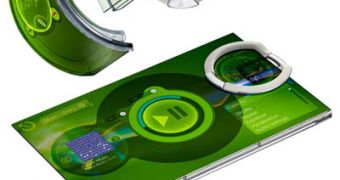A team of US researchers finally managed to break the last obstacle that stood in the way of mobile electronics, as in gadgets and devices that can be bent, stretched and twisted. Thus far, silicon has been an insurmountable difficulty in the path of progress, as the chemical does not allow any kind of reshaping, due to its brittle properties. Now, the team managed to create circuits that can also twist, which is a premiere.
Northwestern University McCormick School of Engineering and Applied Science Joseph Cummings Professor of Civil and Environmental Engineering, and of Mechanical Engineering, Yonggang Huang, responsible mostly for the theoretical part of the research, and University of Illinois Flory-Founder Chair Professor of Materials Science and Engineering, John Rogers, who focused on the experiments associated with the study, are the two scientists who made the breakthrough.
The two have been working on mobile materials for a few years now, developing microcircuits placed on small blocks, which could perform the same functions as their silicon-based counterparts. The truly brilliant part of their work was the mechanism through which they attached the blocks to each other, by using "pop-up bridges," bindings that allow for the 100-micrometer squares to bend and stretch. Before they could call their research a complete success, they had to first create an electronic device that could also twist. They managed to accomplish that by S-shaping the pop-up bridges.
This allows for the circuits to maintain their properties, even under extreme reshapes. "For a lot of applications related to the human body – like placing a sensor on the body – an electronic device needs not only to bend and stretch but also to twist. So we improved our pop-up technology to accommodate this. Now it can accommodate any deformation," Huang explained.
The Proceedings of the National Academy of Sciences (PNAS) journal hosts their research on-line. Applications for such technologies include the construction of super-advanced medical implants, ones that could accommodate the not-so-linear conditions in our bodies. Athletes could also benefit from bionic aid equipments, which could increase their performances.
The team now focuses on applications such as building transparent, multi-layered solar cells, twisting transmitter and communication devices, as well as better microfluidic devices. If their research were to receive more interest and financing, undoubtedly we could expect even more from the team of two.

 14 DAY TRIAL //
14 DAY TRIAL //